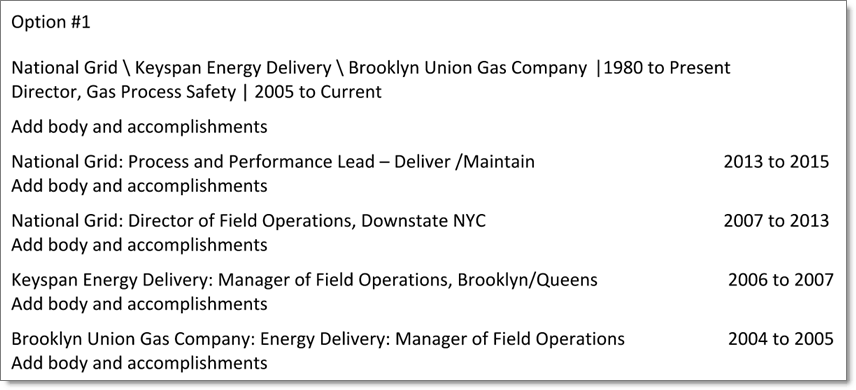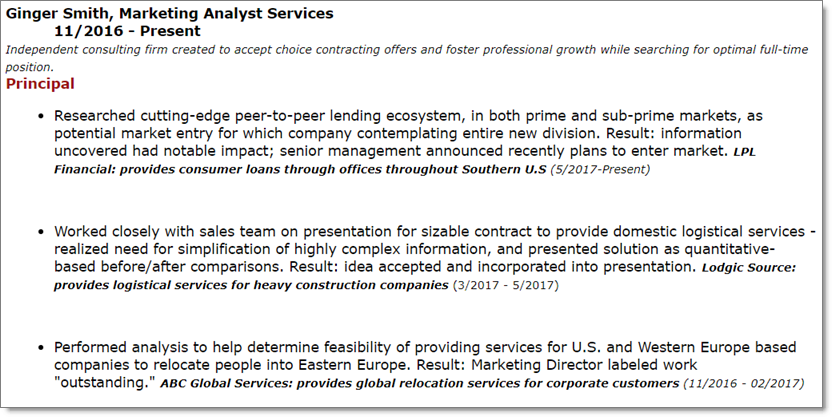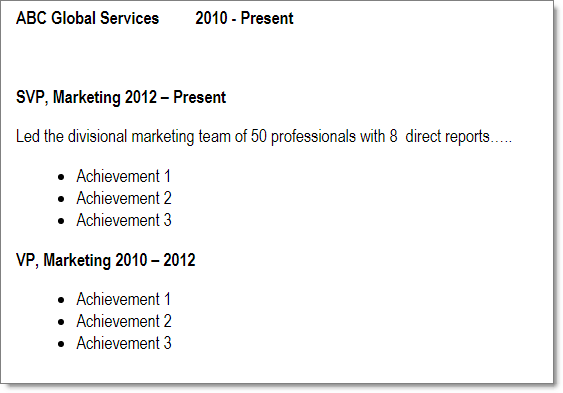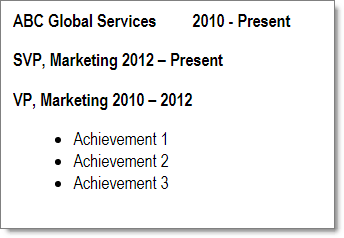This question was something I came up against right when Diana emailed it to me… here’s the question, and the responses from coaches is below:
I have a question about listing consulting positions on a resume. My last 3 jobs were 1099 consulting positions. I was thinking after watching the Extreme Resume Makeover – could having them currently listed as separate positions be causing me to lose out on jobs that I am MORE than qualified for? Looks like I job hop? If so, should I list like:
Consulting Work:
ABC Global Services………..
LodgicSource………..
LPL Financial………….
Or should I list next to the job title:
(Consultant)
Note from Jason: This question can be expanded to talk about one company where you had multiple roles… should you break those roles into separate resume (or LinkedIn) entries, or group them?

If your 1099 consulting roles lasted less than 2-3 years, it will be advantageous to combine them into one listing on both your resume and LinkedIn profile to combat the job hopper perception. My suggestion would be to give your consulting business a name, claim (Type of) Consultant as your title, and describe your achievements with each consulting role in bullets. For example:
As you can see in this example, the emphasis is on your achievements with each company rather than the companies themselves. Take this exact same approach on LI, as recruiters do not like to read multiple job listings with short tenure.
Many professionals face the opposite problem, wherein they have worked for the same company for many years and question whether they should combine all their roles or list them separately.
- If your titles were incidental and you basically held the same position for a very long time punctuated by expanding responsibilities such that you essentially did the same thing for years and years, then it may be difficult to disentangle one position from another. In this case, conflating your titles may be more realistic. However, it will be important to clearly indicated your rise in the company by including all your titles in one listing and stressing the gradual elevation of your authority over time, as well as the continuing nature of key initiatives that continued across your different roles.
- If you held roles in different departments for the same company, then it will make more sense for you to list each position separately so you can stress the cross-functionality of your experience. Recruiters and hiring executives tend to value candidates with this kind of breadth.
- Because recruiters don’t like long LI profiles with many different job listings, it is nearly always advantageous to combine roles with the same company into a single experience entry. Make sure you clarify the dates and titles of each role, however, so recruiters can see your promotion history and the appropriate key words will be included.

Your resume is a marketing document, you don’t need to include everything that you have done, but focus on what’s relevant for the job you are targeting. If some of the consultancy assignments were real ‘stand-out’ ones you could show them separately. They could stand out as they were longer, or there was a strong impact/result.
For the rest, I’d group them into one position – choosing different ones to refer to depending on the target job. This will stop you appearing as a job hopper and show the breadth of your knowledge. Your evidence against this job can include how you are quick to get up to speed/ understand a new culture/influence as an outsider.

In one way, this question is similar to a job seeker who’s been working through an employment agency and has been sent out on various assignments. Because you worked for several companies, do you list those assignments separately? Or do you combine them into one? The fact is there is no rule. So it all comes down to a matter of opinion and judgment. And part of this decision is to look at the overall background and goal of the job seeker. And the structuring of the resume itself.
But with consulting work, I would generally combine them into one listing on your resume. It cleans things up and still allows you to highlight the companies and/or kind of consulting you did. And in the case of gaps between the consulting jobs, having them all combined into one lets you show continuous employment. So on your application, you’d separate them out. But on your resume, you’d show continuous employment during the entire time.
Let’s suppose we combine them into a single job listing on the resume. The question now become whether to include the names of the companies for whom you consulted. Or leave the names out and just have the industries to which those companies belong. And yes, you could even include both if you wanted. For example, here’s how it would look if you listed just the company names:
The advantage of going this route is that you can highlight specific company names that would impress the reader. And fyi, you don’t have to list all the companies for whom you did consulting, You can pick and choose which ones to list.
Now let’s assume you chose to list the consulting work by industry rather than company name. Here is how that would look:
This approach is very helpful if you feel the company names won’t be recognizable to the readers. Or if the companies you consulted for aren’t the size that would impress employers or recruiters. It’s also useful where you want to stress the industries where you consulted. FYI, if your consulting was limited to a particular industry, you could replace my “Multiple or Several” with the industry. And then list the various companies within that industry where you consulted.
If you were to list them separately, or use the combined method, are you still at risk of being seen as a job-hopper? The answer is still yes. So if that’s a big issue to you, one way to handle it would be to leave those bullets out. And just list yourself as a consultant. So just the one line with no info below it. And in a different spot on your resume, that’s where you can list the info that goes along with the consulting work.And yes, you could also remove that “Multiple or Several” in my examples to just have your Consultant title and dates. Here, you’re playing into the assumption by readers that maybe you only consulted for a single client rather than a bunch.
Now if you want to work for a consulting firm rather than for yourself, then job-hopping isn’t an issue at all. In the world of consulting, it’s normal to work for one this time and somebody else next time. So job-hopping is the norm in this field. And happens with those who work for consulting companies and those who are independent contractors working for themselves. So job-hopping is the norm, totally accepted, and not an issue at all. But if you are seeking work in something else, then job-hopping might be an issue in that world.
FYI, the ways I mentioned about how to list consulting and temp work also applies to those of you who may have had differing roles with the same company. Yes, you could decide to list them separately. And include some duties and accomplishments with each one. Or you could combine them into a single listing. And use bullet points to include the KEY accomplishments and duties from all your roles. You can also include a statement that you were promoted from X to Y. Here’s an example to illustrate:
If things get messy or you don’t have enough space to get all the info you want across to readers, then you could split things into more than one listing. And decide which one(s) to list separately and which ones(s) to combine. So yes, you can mix and match with part combined and part listed independently. The bottom line is you have a lot of flexibility to structure thing in the way that works best for you.

This is a complicated question with a variety of answers. Do you want to continue to work as a consultant or are you looking for full-time employment working for a company? Here are a few ideas for either situation.
1099 Transitioning to Full-time Employment
Yes, you do want to avoid looking like a job hopper to the Applicant Tracking System (ATS) or the first reader who gives your resume a 6- to 8-second initial glance. For those of my 1099 clients who wish to work for a company, we have had the most success when we list their 1099/consulting positions under their own company name. Give a brief explanation of the type of work you provide (be sure to include industry keywords in your description), followed by a more resume-style description of each of your 1099 jobs.
Example:
Continue as Consultant, looking for new 1099 jobs
For those of my clients who wish to continue as a consultant and look for new 1099 gigs, we use a completely different approach. As you know, networking is key in finding your next 1099 job, but the document you leave behind or email ahead of time needs to reflect your brand. Your resume in this case should be more of a marketing document with testimonials, services, lists of jobs/clients (if not confidential) and your unique value/brand. You also want to the layout to be visually appealing, as well as easy to scan for important information.

Dear Consultant,
List all your experience under your consulting title and/or business. I suggest using this format.
Be sure each of your bullet points has quantifiable information. You are in finance, so it is important to provide
specifics on how your consulting benefits future clients or an employer. This provides you the stability of ongoing
employment and it accurately portrays your experience.
Also, be consistent across all marketing platforms, LinkedIn profile, online portfolio, and/or website, etc.
However, if you had multiple roles with one company it is important to show progression and identify each one
separately. It is important to put the dates with each position but the entire time you worked with the company
under the company name. Here is an example.
I hope this answered your question.
Wishing you much success in your career!

Yes, it’s a good idea to consolidate consulting roles on your resume. Besides helping to minimize the appearance of being a job hopper, it simplifies your resume and makes it easier to read. The other way to clarify it is by making a note within the line listings of the consulting projects, for example “six-month contract.” Then, a prospective employer won’t think you had a series of short-lived jobs.
There are a few ways to group together consulting roles, including creating a separate section on your resume for “consulting experience,” listing consulting projects under one agency name, if that’s the case, or creating your own business name. It’s also a good idea to group jobs together if your company gets bought out and your old company name no longer exists. Rather than list it as two different employers on your resume, list the new company name on the first line, with the full date range you worked for both employers. Show the different positions you held, listed under the main company header, and for the jobs you had at the old company, put the old company name in parentheses after the job title. This will be particularly helpful if your old company got bought out after you were only there for six months!

Employers will want to get an immediate blueprint of your value–and in situations like this, it is not uncommon to highlight your skills and expertise first, followed by your consultant title and brief naming of your client list. We call this a functional resume. It focuses more on your skill sets, trainings, and certifications and not so much on your work history.
I suggest the following format:
- Start with your name and contact info,
- Professional summary: (2-3 lines qualifying you as a viable candidate)
- Highlights of Skills and Accomplishments/Trainings/
Certs etc comprised of a targeted and bulleted list. You may even want to break it up into mini sections with 4-6 in each. If you can show quantifiable results in your section this will also grab an employers attention (scope of project, ROI, etc) For tons of examples of functional resumes, google “functional resume” with your industry and look at images tab to get ideas on how you can present your work. - Following this section list your Work History. You can even use your “last name” and “consulting” as your company name and then list the client name, city, and duration of each consultant gig on a separate line. No need to list out responsibilities for each role here as that can be highlighted in your selected skills & accomplishment section that precedes this. The idea is to communicate your strengths as a targeted and complete package to the employer’s needs, not as a hodge-podge of different short time gigs with various roles & duties.
As for being viewed as a job hopper–It is all how you present it. Some may very well see it that way–however, if you are good at what you do, you can communicate how much you gave & gained working on these special projects. Being hired as a consultant carries a lot more weight than as just a contractor so wear that difference proudly! You were a hired gun for a specific job because of your expertise in a particular area and that is something of value to note.
Part B: List roles separately or as 1 grouping? If you have only worked at 1 company for the past 20+ years and you want to highlight how you have moved up the company ladder–use the company name as a header and then follow with 1 title of each role you had, followed by the years in that role and a brief description of what you did beneath it. 2-3 brief action verb sentences to give context of your role followed by a couple of bullet points to highlight your achievements. If you have more than 2 companies to list and the experience from company 3 and 4 is just as valuable as your last role–then just list your most current role at said company–and you can make mention of how you moved up in your cover letter or briefly mention your promotions in your summary section or job description. The bottom line is this: Every word should be of value to the employer–not be used as an opportunity to justify or showcase your own self-worth. If responsibilities of your first job with the company don’t serve your future employer in any way–then don’t put it on there. Everything is prime real estate on a resume–so choose your words carefully and make them count!

Résumé format is important, but content is critical. That said, you raise an excellent question that also applies to an individual holding several positions at one company. I suggest that you combine the consulting projects under one heading, such as [Your Name] Consulting, and indenting the individual projects with descriptions. For example:
Descriptions should be concise and loaded with key words that are clearly demonstrating your skills and experience which appeal to automated recruiter software looking for YOU!

When putting together your resume as a consultant, you want it clean, easy to read, and relevant! Remember, you are creating your personal brand here, and you want to keep it organized while marketing and highlighting your skills and accomplishments. Since your perspective clients or employers are looking for someone in particular, you want to be sure that you are including details about your projects, along with quantifiable achievements for each project so that they know that you have what it takes. Your goal here is to grab the reader’s attention, and you certainly want to avoid bouncing around with dates. The best part about a consultant resume, is that they are easy to tailor for a specific position or client, and you can leave out anything that doesn’t relate directly to the position. I realize that the act of creating a new resume for each job you apply for can be tiresome, but in the end, if it lands you that project or job, isn’t it worth it?
For a Consultant resume, my focus is typically more on the functional side – showcasing and highlighting skills and achievements. I typically present consulting work by grouping all projects together. Many consider themselves a Consultant, so they list themselves as a Freelance Consulting Firm, or just Consultant and then I combine all projects under that umbrella. Grouping all consulting work into a single time block will better control the readers perception of any gaps or longevity, because even when you aren’t working on a project, you are still a consultant, and may be in between projects.
An example would be:
In a company where you have held several positions, I generally find this to be a different scenario, however. Because roles vary from position to position, sometimes you really do need to create a separate section for each job title. In some cases, however, when there isn’t much change or diversity within the roles, you can group the position titles together. In general, it is always a good idea to have a second or third pair of eyes on your resume. Does it flow well? Does it grab the readers attention? Are you getting your point across and showcasing and highlighting your accomplishments in each role? Are you repeating yourself in order to fill space? Remember to strive for clean, easy to read and relevant!

Since you are a 1099, theoretically, you own your own business and, I advise you to list it as such. If you worked through a third-party source, you can say partnering with ABC Consulting. This method is not deceptive since 1099 employees work for themselves and your pay stubs and 1099n tax forms will verify this.
Example:
In the body for each assignment you can break down whom you reported to, the nature of the project with
applicable metrics including on time and on-budget delivery.
In the case of listing multiple roles in the same and or a merged /acquired company, there are two ways to go on a
resume depending on how relevant the prior information is and whether you want to emphasize it or minimize it.
You can also group these positions if you have been in a company a long time and/or moved from lower level to
executive level roles. The key is always to highlight jobs that are relevant to the jobs you are applying for.
As for LinkedIn, for the 1099, I advise listing it as a position under your business name and breaking down the
assignments in the body.
For long-term employees, I advise listing each role separately on LinkedIn for maximum key work optimization.

A resume is about communicating your value as professional for the purpose of generating an interview for a job you desire. Keeping this in mind, what is the best way to communicate this scenario to serve our purpose?
I would not combine different positions held with the same company. This is a completely different scenario than someone doing contracting gigs. This shows a pattern of progression, that the candidate is promotable, able to learn and adapt, able to handle additional responsibilities, and able to take on increased complexity and sophistication of work.
I would combine positions under 1099 activity. Many professionals do consulting work when they’re between full time (W-2) jobs. It’s a way to stay sharp, engaged, and visible. Let’s assume this person is an experienced Marketing Analyst: here is how I would present it on the resume:

You were actually self-employed during that time, so there was only one employer (you). That’s why you received 1099’s–you were an independent contractor. This is the logical way to present that time period, and this treatment sidesteps the obstacle of listing multiple consulting clients.
Recently, I helped a lean performance improvement expert who did consulting work for C-level executives. I combined his consulting work, showing it as one “employer,” with the heading “Independent Consultant.” A bulleted list briefly described his most notable consulting achievements.

When your last three jobs were all 1099 consulting positions and you are in a current job search seeking another position, I would suggest combining your consulting (1099) positions into one descriptive position and use beginning and ending dates for the entire three years. This avoids someone reading your resume to think you had three short stints or are a job-hopper.
I’d suggest the following sample format:
When you have worked for a company and have held multiple positions with in the same company, List the company and your beginning and ending years. Then list each position held and your achievements (no more than three) per position held. For each position, the years should be listed. This format should be used for recent and one previous position (within the past 10 years) positions only.
For the second page positions and more than 10 years ago…group them and list the overall achievements:

The short answer I have is ‘it depends’. Considerations include:
- 1) how long the consulting gigs lasted
- 2) how prestigious the company
- 3) depth of other experience
If the consulting gigs lasted less than six months or were insignificant in depth and scope, I might advise grouping them under a heading ‘Consulting Work’. If the each gig lasted for a significant length of time and/or were instrumental in depth and scope, I might advise to list separately with the position title ‘consultant’. I would advise similarly if the consulting work was performed at a reputable company, globally and/or within your industry. This would draw attention to the fact you were a consultant for a significant player, thus showcasing prestige.
Since a resume is a document to grab attention and keep the reader interested in engaging with you further, length should always be a consideration. If your consulting work is in addition to years of relevant work experience, grouping may save space and present your experience in a more concise, visually appealing way. If you are newer to the workforce or to the field, showcasing your experience more in depth will give the reader a better sense of the experience you have gained that isn’t highlighted anywhere else on your document.
Regardless of how you format your document, you can include a one sentence header or bullet under your professional summary that captures your consulting experience and positions you as a thought leader in your industry. Something like “Global Financial Services consultant at Fortune 100 Companies: ABC Global, LogicSource, LPL Financial” or something similar.
Wasn’t that a great roundup from our coaches? Hopefully this helps you figure out how to create this part of your resume!
















